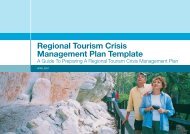Tourism Risk Management - Sustainable Tourism Online
Tourism Risk Management - Sustainable Tourism Online
Tourism Risk Management - Sustainable Tourism Online
Create successful ePaper yourself
Turn your PDF publications into a flip-book with our unique Google optimized e-Paper software.
1. Must do.<br />
2. Should do.<br />
3. Could do.<br />
STEP 4 – Evaluate <strong>Risk</strong>s<br />
Decisions have to be made about which risks have to be treated and in what order. The previous<br />
activities in risk analysis will provide the information on which to make those decisions. Decisions on<br />
risk treatment needs and priorities must be aligned with the destination’s expectations, values and<br />
perceptions of risk.<br />
1. Establish treatment needs and priorities in descending order. Where the same rating level is<br />
allocated to a number of risks, the protection of life should be a higher priority than protection<br />
measures for property, infrastructure, utilities or the environment.<br />
2. Stakeholder consultation is essential.<br />
3. Document:<br />
• The risks which are not to be treated.<br />
• The risks which will be treated in order of priority.<br />
• How the decisions were arrived at.<br />
Always monitor and review risks that you decide not to treat because priorities and circumstances<br />
may change over time.<br />
STEP 5 – Treat <strong>Risk</strong>s<br />
Before risks can be treated it is necessary to identify the options available, to assess the relative<br />
merits of each, and to select the most appropriate. <strong>Risk</strong> treatment plans should then be developed<br />
and implemented.<br />
Standard risk treatment options available include:<br />
• avoid the risk - choose not to proceed with an activity likely to generate risk;<br />
• reduce the likelihood of consequences by modifying the risk;<br />
• reduce the consequences of occurrence - by modifying susceptibility (exposure to the risk eg,<br />
through best practice systems: building evacuation plans, sprinkler systems and trained staff<br />
will reduce the consequences of fire in a visitor hotel) and/or increasing resilience (capacity to<br />
sustain losses);<br />
• transfer the risk – have another party accept or share the risk (eg, insurance companies – are<br />
the premiums affordable, is protection available?);<br />
• retain the risk - accept the risk and plan to manage the consequences (but only if the<br />
consequences are able to be managed without adversely affecting the destination or the<br />
perceptions of visitors);<br />
30 <strong>Tourism</strong> <strong>Risk</strong> <strong>Management</strong> – An Authoritative Guide to Managing Crises in <strong>Tourism</strong>
















